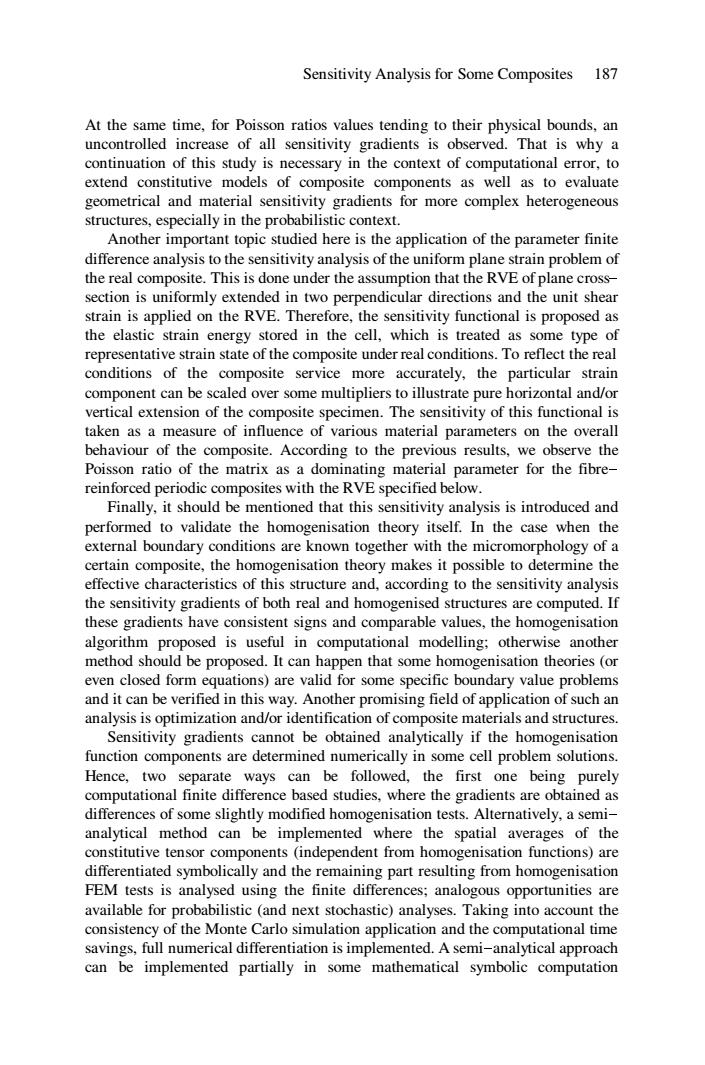正在加载图片...

Sensitivity Analysis for Some Composites 187 At the same time,for Poisson ratios values tending to their physical bounds,an uncontrolled increase of all sensitivity gradients is observed.That is why a continuation of this study is necessary in the context of computational error,to extend constitutive models of composite components as well as to evaluate geometrical and material sensitivity gradients for more complex heterogeneous structures,especially in the probabilistic context. Another important topic studied here is the application of the parameter finite difference analysis to the sensitivity analysis of the uniform plane strain problem of the real composite.This is done under the assumption that the RVE of plane cross- section is uniformly extended in two perpendicular directions and the unit shear strain is applied on the RVE.Therefore,the sensitivity functional is proposed as the elastic strain energy stored in the cell,which is treated as some type of representative strain state of the composite under real conditions.To reflect the real conditions of the composite service more accurately,the particular strain component can be scaled over some multipliers to illustrate pure horizontal and/or vertical extension of the composite specimen.The sensitivity of this functional is taken as a measure of influence of various material parameters on the overall behaviour of the composite.According to the previous results,we observe the Poisson ratio of the matrix as a dominating material parameter for the fibre- reinforced periodic composites with the RVE specified below. Finally,it should be mentioned that this sensitivity analysis is introduced and performed to validate the homogenisation theory itself.In the case when the external boundary conditions are known together with the micromorphology of a certain composite,the homogenisation theory makes it possible to determine the effective characteristics of this structure and,according to the sensitivity analysis the sensitivity gradients of both real and homogenised structures are computed.If these gradients have consistent signs and comparable values,the homogenisation algorithm proposed is useful in computational modelling;otherwise another method should be proposed.It can happen that some homogenisation theories(or even closed form equations)are valid for some specific boundary value problems and it can be verified in this way.Another promising field of application of such an analysis is optimization and/or identification of composite materials and structures. Sensitivity gradients cannot be obtained analytically if the homogenisation function components are determined numerically in some cell problem solutions. Hence,two separate ways can be followed,the first one being purely computational finite difference based studies,where the gradients are obtained as differences of some slightly modified homogenisation tests.Alternatively,a semi- analytical method can be implemented where the spatial averages of the constitutive tensor components (independent from homogenisation functions)are differentiated symbolically and the remaining part resulting from homogenisation FEM tests is analysed using the finite differences;analogous opportunities are available for probabilistic (and next stochastic)analyses.Taking into account the consistency of the Monte Carlo simulation application and the computational time savings,full numerical differentiation is implemented.A semi-analytical approach can be implemented partially in some mathematical symbolic computationSensitivity Analysis for Some Composites 187 At the same time, for Poisson ratios values tending to their physical bounds, an uncontrolled increase of all sensitivity gradients is observed. That is why a continuation of this study is necessary in the context of computational error, to extend constitutive models of composite components as well as to evaluate geometrical and material sensitivity gradients for more complex heterogeneous structures, especially in the probabilistic context. Another important topic studied here is the application of the parameter finite difference analysis to the sensitivity analysis of the uniform plane strain problem of the real composite. This is done under the assumption that the RVE of plane crosssection is uniformly extended in two perpendicular directions and the unit shear strain is applied on the RVE. Therefore, the sensitivity functional is proposed as the elastic strain energy stored in the cell, which is treated as some type of representative strain state of the composite under real conditions. To reflect the real conditions of the composite service more accurately, the particular strain component can be scaled over some multipliers to illustrate pure horizontal and/or vertical extension of the composite specimen. The sensitivity of this functional is taken as a measure of influence of various material parameters on the overall behaviour of the composite. According to the previous results, we observe the Poisson ratio of the matrix as a dominating material parameter for the fibrereinforced periodic composites with the RVE specified below. Finally, it should be mentioned that this sensitivity analysis is introduced and performed to validate the homogenisation theory itself. In the case when the external boundary conditions are known together with the micromorphology of a certain composite, the homogenisation theory makes it possible to determine the effective characteristics of this structure and, according to the sensitivity analysis the sensitivity gradients of both real and homogenised structures are computed. If these gradients have consistent signs and comparable values, the homogenisation algorithm proposed is useful in computational modelling; otherwise another method should be proposed. It can happen that some homogenisation theories (or even closed form equations) are valid for some specific boundary value problems and it can be verified in this way. Another promising field of application of such an analysis is optimization and/or identification of composite materials and structures. Sensitivity gradients cannot be obtained analytically if the homogenisation function components are determined numerically in some cell problem solutions. Hence, two separate ways can be followed, the first one being purely computational finite difference based studies, where the gradients are obtained as differences of some slightly modified homogenisation tests. Alternatively, a semianalytical method can be implemented where the spatial averages of the constitutive tensor components (independent from homogenisation functions) are differentiated symbolically and the remaining part resulting from homogenisation FEM tests is analysed using the finite differences; analogous opportunities are available for probabilistic (and next stochastic) analyses. Taking into account the consistency of the Monte Carlo simulation application and the computational time savings, full numerical differentiation is implemented. A semi-analytical approach can be implemented partially in some mathematical symbolic computation